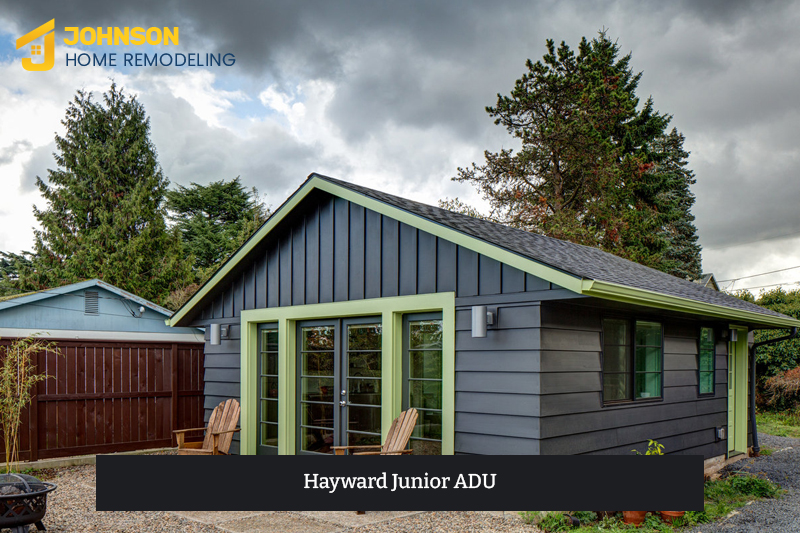Explore how Junior Accessory Dwelling Units (JADUs) in Hayward serve as a viable solution to the housing crisis. JADUs not only boost rental income but also contribute to reducing the carbon footprint and fostering community development by transforming underutilized spaces into functional living units.

A Junior Accessory Dwelling Unit (JADU) is a compact living space within a single-family home, designed to offer additional accommodation while maintaining a connection to the primary residence. Known as “in-law units” or “granny flats,” JADUs are capped at a maximum of 500 square feet. They feature a separate entrance, bathroom, and kitchenette, enabling independent living while promoting flexibility and privacy.
According to the California Department of Housing and Community Development, JADUs are increasingly popular for their ability to address housing shortages by providing affordable living options within existing structures (Source: California Department of Housing and Community Development).
Building a JADU in Hayward involves adhering to specific regulations:
When designing an Accessory Dwelling Unit (ADU), consider factors to ensure a well-planned and functional space. Align the size and layout with occupants’ needs and the homeowner’s budget. Optimize available space while prioritizing natural light, ventilation, and energy efficiency.
Ensure accessibility and privacy with features like wide doorways and separate entrances. Harmonize aesthetics with the main house and neighborhood. Plan carefully to align design choices with the budget.
| Design Consideration | Description |
| Size and layout | Consider the needs of the occupants and the budget of the homeowner when determining the size and layout of the ADU. |
| Natural light and ventilation | ADUs should have plenty of natural light and ventilation to create a comfortable and healthy living space. |
| Energy efficiency | ADUs should be designed to be energy-efficient to reduce operating costs. |
| Accessibility | ADUs should be accessible to people of all abilities. |
| Noise reduction | ADUs should be designed to reduce noise transfer between the main house and the ADU. |
| Privacy and security | ADUs should have their private entrance and exit and be secure from unauthorized access. |
| Aesthetics | The ADU should be aesthetically pleasing and complement the main house and the surrounding neighborhood. |
Building a Junior Accessory Dwelling Unit can be affordable and cost-effective to increase housing options. However, it is essential to understand the various costs involved and explore financing options for homeowners.
Building a Junior ADU in Hayward can vary based on location, size, configuration, materials, and labor costs. According to a study by UC Berkeley’s Terner Center for Housing Innovation, the average cost of constructing a JADU in California ranges from $50,000 to $75,000. This includes design fees, permits, construction costs, and utility connections.
There are various financing options available for homeowners looking to build a JADU. Options include personal savings or cash-out refinance, where homeowners can use their savings or home equity to fund the construction of a JADU. Homeowners can also take out a traditional loan, such as a home equity line of credit (HELOC) or home equity loan, to finance their JADU project.
Additionally, some cities and states offer government programs that provide financial assistance or incentives for homeowners interested in building a JADU. It is worth researching if any programs are available in your area.
In addition to the traditional financing options mentioned above, homeowners can explore alternative funding sources for building a JADU. These may include crowdfunding, where homeowners can use online platforms to raise funds from friends, family, or the community to finance their JADU project.
Homeowners can also consider loans from family or friends to fund the construction of a JADU. Additionally, some organizations offer grants or scholarship programs for homeowners looking to build an affordable housing unit on their property.

The increasing popularity of Junior ADUs in Hayward has sparked a discussion about its potential impact on sustainable urban development. By utilizing existing infrastructure and land resources, JADUs can help promote sustainable growth in urban areas.
JADUs allow homeowners to expand their living space and generate rental income. Homeowners can address the affordable housing issue in cities by converting underused areas like basements, garages, or attics into habitable spaces. This innovative solution offers a win-win, maximizing property potential while mitigating the housing crisis.
Strategically using existing structures and promoting infill development, the Joint Accessory Dwelling Unit (JADU) initiative reduces the need for new construction. This approach minimizes urban sprawl and curbs greenhouse gas emissions by repurposing and maximizing existing spaces. JADU aligns with smart growth and environmental conservation principles.
JADU is an ideal housing option for older adults who want to age in place while maintaining independence and staying close to family. These innovative living spaces provide privacy and comfort near loved ones, offering security, convenience, and a harmonious intergenerational living experience.
JADUs foster multi-generational living, strengthening family bonds and promoting neighborhood social interaction. With their functionality and community-building potential, JADUs can transform neighborhoods into thriving, inclusive communities.
In conclusion, Junior ADUs offer many benefits to homeowners, including increased housing options, potential rental income, and a model for sustainable urban development. However, it is essential to consider the costs of building a JADU and explore the various financing options available.
With proper planning, Junior ADUs can be a valuable addition to any property and contribute to addressing the affordable housing crisis in our communities. So, if you are a homeowner in Hayward or surrounding areas, do not hesitate to research and consider building a Junior ADU on your property. It could be a win-win situation.
If you are considering building a Junior ADU in Hayward and exploring financing options, contact us at (510) 995-0323. Our experts will guide you through the process and answer any questions.